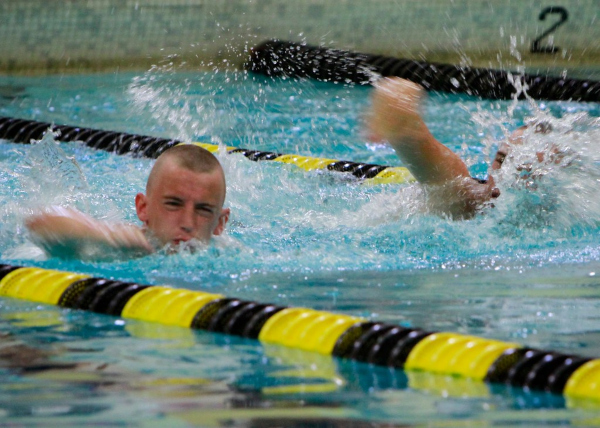Knowing how to swim is especially important to the United States Navy. It is one of the few military branches that make it mandatory for recruits to complete a Navy Swim Test prior to graduating boot camp.
Therefore, swimming is just as important in the U.S. Navy as being able to run a mile or do push-ups.
While you should take the time to prepare for the Navy Swim Test this is not meant to alarm you into thinking it’s impossible to complete the requirement.
All you need is a little practice and preparation to earn your Third-Class Navy Swimmer designation.
Learn more about the Navy Swim Test by reading the complete article along with a suggested workout plan.
Related Article – Navy Boot Camp Schedule
Table of Contents
What is the Navy Swim Test?
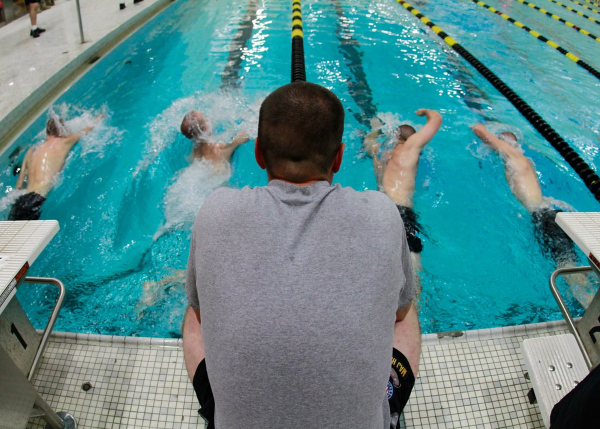
The United States Navy makes it mandatory that all recruits complete a Third-Class Swimmer qualification as part of its basic training.
The U.S. Navy is different from other military branches like the Army and National Guard, which have no such requirement.
There is an obvious need to be able to survive in water since most sailors spend a portion of their duty in an ocean or near a major body of water.
Furthermore, learning to become a dependable swimmer now can prepare you for an opportunity in the Marine Corps (or with a Navy special ops unit like the esteemed Navy SEALs).
The U.S. Navy Swim Skills Assessment Test determines your placement as a swimmer.
Further testing is often required for more advanced positions in the Navy but for basic training, all you need is the Third Class ranking.
The Navy Swim Test is conducted during basic training for recruits who have enlisted.
Meanwhile, the officer accession training (OCS) determines swimming placement for individuals entering at higher ranks.
Finally, the U.S. Naval Academy and ROTC programs can provide the certification.
The purpose of the Navy swim test is to be comfortable enough in the water that you don’t panic.
Consequently, if you are not already seasoned wading and swimming around in the water, it’s a good idea to take swimming lessons at your local pool.
Not everyone in the Navy has to be an elite swimmer, you just need to demonstrate basic awareness and conditioning.
Related Article – How To Prepare Physically For Navy Boot Camp
Third-Class Navy Swim Test
The Navy Swim Test that most recruits need to complete is the Third-Class designation.
It is a really straightforward examination with the primary purpose of staying afloat in the water without the need for a personal flotation device (PFD).
The Navy Swim Test consists of two sections with the first module consisting of 3 different events:
- Deep Water Jump
- 50 Yard Swim
- 5 Minutes Prone Float
Swimmers are allowed to use any stroke to complete the 50-yard (or half of a football field) swim.
Those who complete module one advance to the second portion of the Third-Class Swim Test.
Here, swimmers need to demonstrate the ability to stay afloat in the water by using their clothes as a floating device as opposed to removing them.
The Navy strongly discourages swimmers from the latter approach because it can result in hypothermia.
Thus, new recruits need to demonstrate a basic ability to adapt to their surroundings and use their clothes as floating devices to remain in the water long enough for emergency personnel to arrive.
It may sound complicated but ultimately all you need to do is research and practice many of the simple ways this can work in the water that the Navy will pass as sufficient.
Second-Class Navy Swim Test
The Navy Second-Class test is reserved for more demanding positions within the Navy that require more advanced swim and survival techniques.
While the third-class exam only determines if a person can survive long enough for emergency personnel to arrive (5 minutes in the case of the test), second-class swimmers must remain in the water indefinitely.
The Navy determines this qualification by having the swimmer complete the 5-minute prone float (front and back) immediately after these two activities:
- Deep Water Jump
- 100 Yard Swim
Recruits must complete the 100-yard swim utilizing each technique (crawl stroke, breaststroke, sidestroke, and elementary backstroke) at 25-yard increments.
If you plan to enlist in the Navy as a small boat operator, aircrew, or rescue swimmer – you’ll need to reach Second-Class qualification.
First-Class Navy Swim Test
As you might expect, the First-Class Navy Swim Test is reserved for the highest-level swimmers within the military branch.
It is used to certify Navy swimming instructors and requires far more of a commitment.
First, candidates must obtain a Red Cross or YMCA lifeguard or life-saving certificate.
The Navy Swim Test requires candidates to demonstrate proficiency with all four swimming strokes.
There is an additional requirement to perform a 25-yard underwater swim where you may only surface twice.
Related Article – Is Navy Boot Camp Hard?
What is the purpose of the Navy Swim Test?
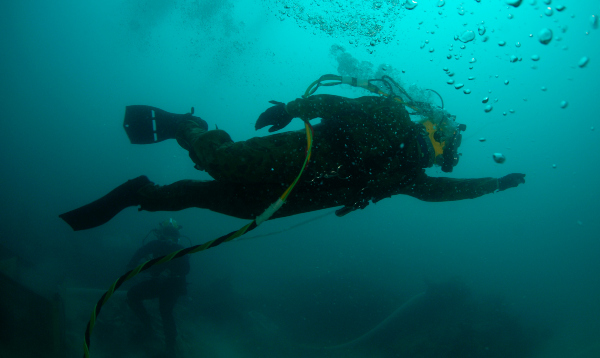
The U.S. Navy Swim Test – like most examinations – may seem pointless yet it’s important for a reason.
Everyone who joins the Navy needs to be at least comfortable in or around water, as well as know how to employ basic survival skills.
Additionally, as recruits progress through the various classifications (if they wish), you’ll see how it applies to real-life situations.
For example, the challenging 25-yard underwater swim may seem trivial but it’s designed to recreate what an environment may look like where you can’t remain above water for long.
It’s also important that you at least learn and occasionally practice your swimming strokes to know the best methods for traversing through open water.
You’ll find that most of the Navy ratings do not require a high degree of aptitude in the water though being able to survive in the water already makes you unique.
In fact, the Red Cross reports that more than half of Americans don’t know how to swim!
Frequently Asked Questions
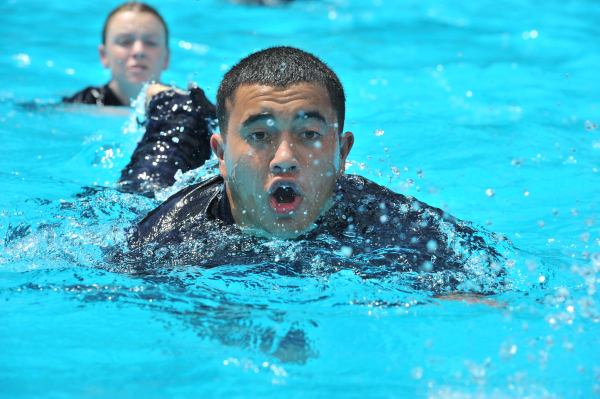
Swimming is scary to a lot of folks in the United States, but you don’t have to worry about it.
Taking swimming lessons early in life is a good survival skill and is also a phenomenal way to condition.
It also gains you confidence in the water, so passing the Navy Swim Test will be a breeze:
How hard is the test?
The Third-Class Navy Swim Test is really straightforward to pass as long as you are already comfortable in the water.
Nonetheless, now that you know what it takes to gain the certification, why not practice at your local pool?
Swimmers may struggle with different portions of the test.
For example, if you don’t like heights, the 5 or 10-foot platform may intimidate you more for the deep water jump.
However, the 50-yard swim is more challenging for recruits who are in poor shape or haven’t practiced their breaststroke enough.
What happens if I fail the swim test?
As long as you’ve been in the water before and have basic swimming skills you’ll obtain the Third-Class designation.
What gets most swimmers in trouble is the prone float that involves using your clothes (but not all of them) to remain above the water.
There are a lot of simple strategies to stay afloat using a piece of clothing but if you don’t look them up or practice beforehand, you may fail.
In the end, practice makes perfect. So don’t be afraid to dive in where the conditions are safe.
Can I join the Navy if I can’t swim?
Yes, the U.S. Navy does offer remedial swim training for those who have never been in the water before.
However, it is discouraged as you have to learn on your own time and you’ll already get behind at boot camp.
It’s far easier to enroll in swimming lessons at your local pool and get over your fear of the water before you enlist in the Navy.
Furthermore, swimming is one of the best ways to stay in shape, and becoming an advanced swimmer could help you join the Navy SEALs one day.
Related Article – Navy Height & Weight Standards
Conclusion
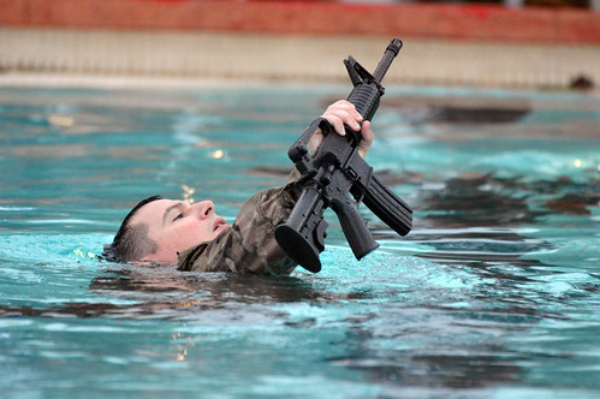
Swimming is a hard cardiovascular activity.
The water is cold and dark and scary.
All of these are reasons not to become a good swimmer.
However, in the U.S. Navy, nothing benefits you more than arriving at boot camp in good physical condition and already comfortable in the water.
You can find some excellent beginner swimmer workouts on Shape.com.
See Also
- Replacing Dog Tags: 6 Things You Need to Know - June 28, 2024
- Navy OAR Test Study Guide - June 24, 2024
- 10 Best Sniper Movies of all Time - June 20, 2024
Originally posted on February 16, 2021 @ 9:18 pm
Affiliate Disclosure: This post may contain affiliate links. If you click and purchase, I may receive a small commission at no extra cost to you. I only recommend products I have personally vetted. Learn more.
